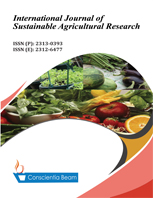Exploring morphological diversity in carrot (Daucus carota l.) germplasm: A multivariate analysis approach
DOI:
https://doi.org/10.18488/ijsar.v11i2.3797Abstract
This study looks at how quantitative parameter variation changes over two years in different carrot accessions and the genetic diversity that exists in a group of accessions that come from different parts of the world. An analysis of variance (ANOVA) was conducted to assess the significance of different factors, including the block effect, treatment effect, and check effect. The result indicated a significant mean sum of squares across various sources of variation. Both adjusted and unadjusted block and treatment effects were significant for all traits, while the check effect was significant for more. During both years, there was moderate to high variation in quantitative parameters for numerous quantitative traits among carrot accessions. Mature leaf length showed the highest variation, followed by mature leaf width, leaf area, root weight, leaf weight, and plant biomass. Principal component analysis revealed distinct patterns in the contributions of parameters during both years. Plotting carrot accessions on the scatter plot using the first three principal components also revealed an informative spread of accessions. A notable increase in variation during the second year was observed. Moreover, accessions from different continents displayed varying degrees of genetic diversity, with Asian accessions exhibiting the highest levels. These findings underscore the importance of global germplasm collection in breeding programs aimed at enhancing crop resilience and productivity. Leveraging this genetic diversity through advanced breeding strategies holds promise for developing cultivars capable of adapting to changing environmental conditions and meeting the demands of sustainable agriculture.

